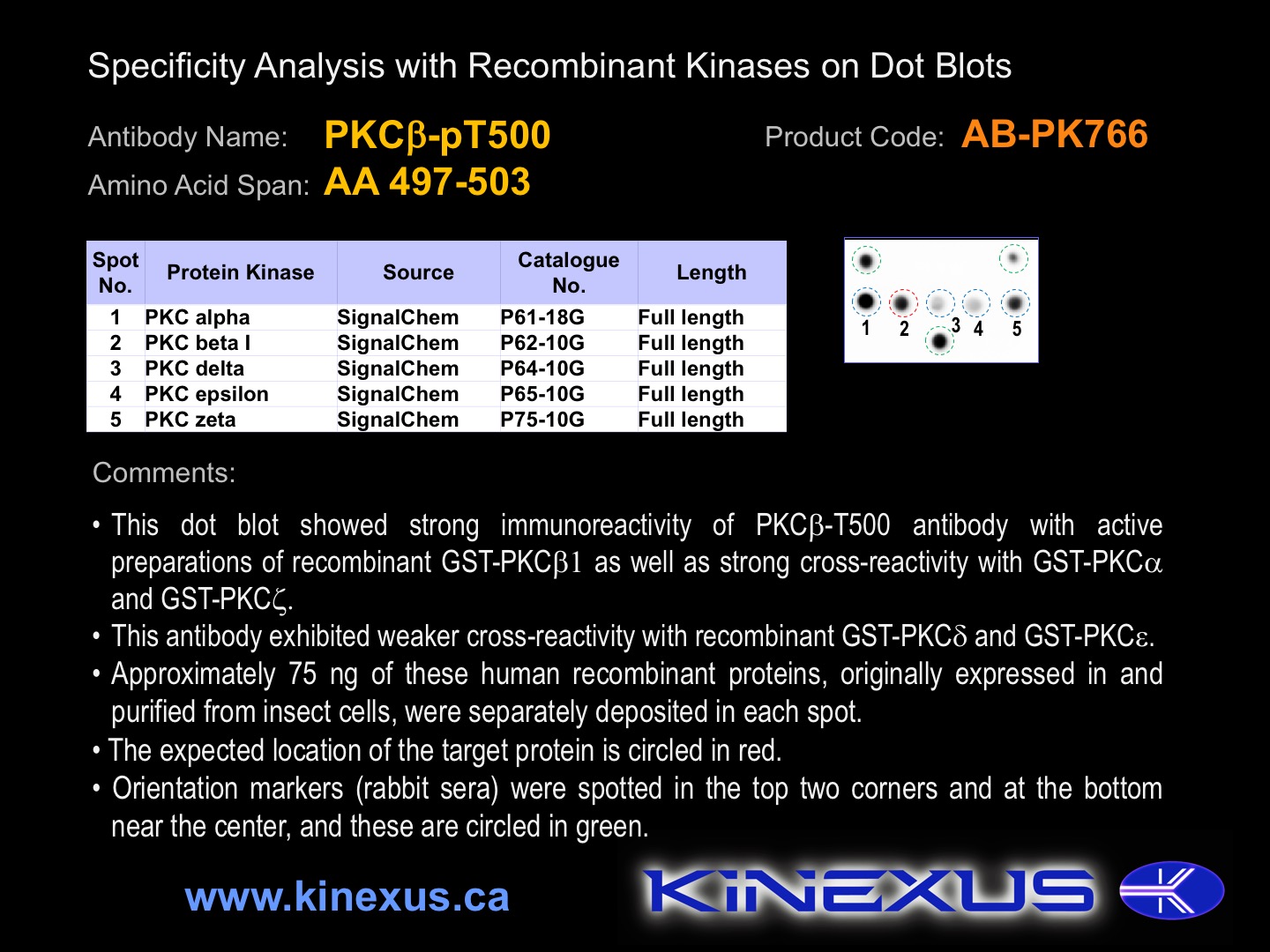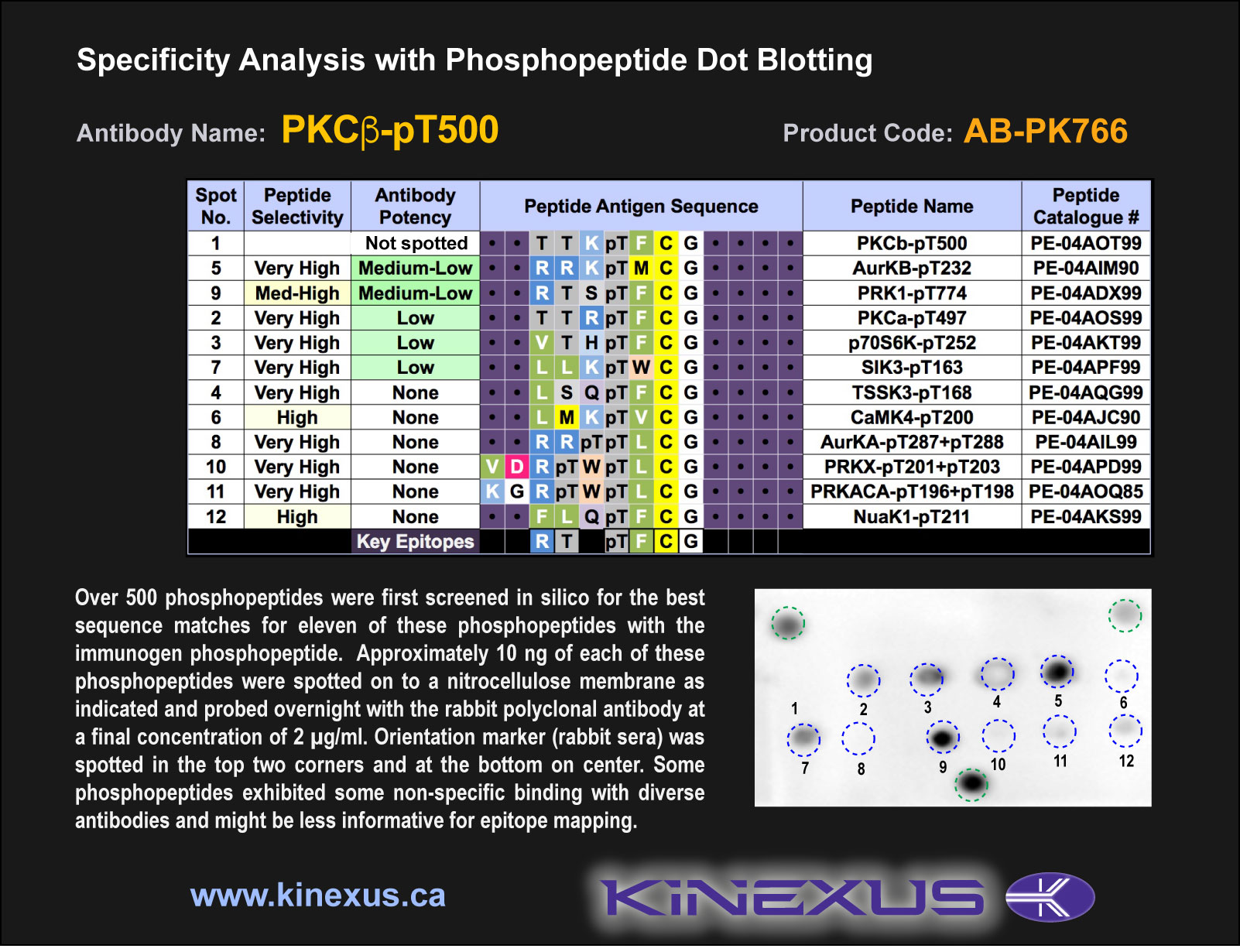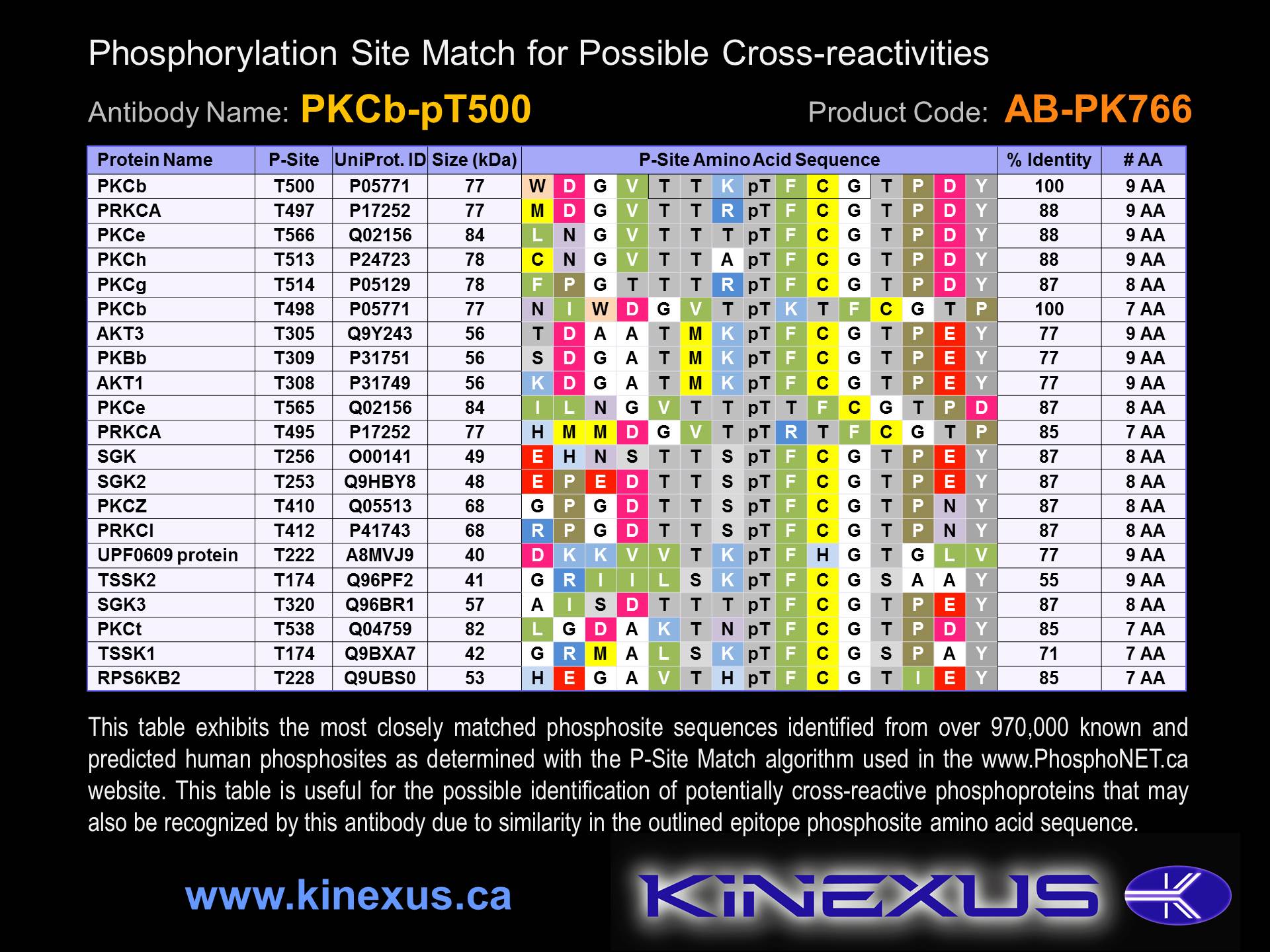Product Name: PKCb-pT500
Product Number: AB-PK766
| Size: | 25 µg | Price: | 89.00 | |
| $US |
Target Full Name: Protein-serine kinase C beta 1
Target Alias: Kinase PKC-beta; KPCB; MGC41878; PKC II; PKC-B; PKC-beta; PKC-II; PRKCB; PRKCB1; PRKCB2; Protein kinase C, beta type
Product Type Specific: Protein kinase phosphosite-specific antibody
Antibody Code: PK766
Antibody Target Type: Phosphosite-specific
Antibody Phosphosite: T500
Protein UniProt: P05771
Protein SigNET: P05771
Antibody Type: Polyclonal
Antibody Host Species: Rabbit
Target Alias: Kinase PKC-beta; KPCB; MGC41878; PKC II; PKC-B; PKC-beta; PKC-II; PRKCB; PRKCB1; PRKCB2; Protein kinase C, beta type
Product Type Specific: Protein kinase phosphosite-specific antibody
Antibody Code: PK766
Antibody Target Type: Phosphosite-specific
Antibody Phosphosite: T500
Protein UniProt: P05771
Protein SigNET: P05771
Antibody Type: Polyclonal
Antibody Host Species: Rabbit
Antibody Immunogen Source: Human PKCb (PRKCB1) sequence peptide Cat. No.: PE-04AOT99
Antibody Immunogen Sequence: TTK(pT)FCG(bA)C
Antibody Immunogen Description: Corresponds to amino acid residues T497 to G503; In protein kinase catalytic domain activation T-loop between subdomains VII and VIII.
Antibody Immunogen Sequence: TTK(pT)FCG(bA)C
Antibody Immunogen Description: Corresponds to amino acid residues T497 to G503; In protein kinase catalytic domain activation T-loop between subdomains VII and VIII.
Production Method: The immunizing peptide was produced by solid phase synthesis on a multipep peptide synthesizer and purified by reverse-phase hplc chromatography. Purity was assessed by analytical hplc and the amino acid sequence confirmed by mass spectrometry analysis. This peptide was coupled to KLH prior to immunization into rabbits. New Zealand White rabbits were subcutaneously injected with KLH-coupled immunizing peptide every 4 weeks for 4 months. The sera from these animals was applied onto an agarose column to which the immunogen peptide was thio-linked. Antibody was eluted from the column with 0.1 M glycine, pH 2.5. Subsequently, the antibody solution was neutralized to pH 7.0 with saturated Tris.This antibody was also subject to negative purification over phosphotyrosine-agarose.
Antibody Modification: Unconjugated. Contact KInexus if you are interest in having the antibody biotinylated or coupled with fluorescent dyes.
Antibody Modification: Unconjugated. Contact KInexus if you are interest in having the antibody biotinylated or coupled with fluorescent dyes.
Antibody Concentration: 1 mg/ml
Storage Buffer: Phosphate buffered saline pH 7.4, 0.05% Thimerasol
Storage Conditions: For long term storage, keep frozen at -40°C or lower. Stock solution can be kept at +4°C for more than 3 months. Avoid repeated freeze-thaw cycles.
Product Use: Western blotting | Antibody microarray
Antibody Dilution Recommended: 2 µg/ml for immunoblotting
Antibody Potency: Strong immunoreactivity with immunogen peptide on dot blots.
Antibody Species Reactivity: Human
Antibody Positive Control: The observed molecular mass of the processed target protein on SDS-PAGE gels is reported to be around 75-85 kDa.
Storage Buffer: Phosphate buffered saline pH 7.4, 0.05% Thimerasol
Storage Conditions: For long term storage, keep frozen at -40°C or lower. Stock solution can be kept at +4°C for more than 3 months. Avoid repeated freeze-thaw cycles.
Product Use: Western blotting | Antibody microarray
Antibody Dilution Recommended: 2 µg/ml for immunoblotting
Antibody Potency: Strong immunoreactivity with immunogen peptide on dot blots.
Antibody Species Reactivity: Human
Antibody Positive Control: The observed molecular mass of the processed target protein on SDS-PAGE gels is reported to be around 75-85 kDa.
Related Product 1: PKCb-pT500 blocking peptide
Related Product 2: PKCd-pY313 phosphosite-specific antibody (Cat. No.: AB-PK768)
Related Product 3: PKCb-pS661 phosphosite-specific antibody (Cat. No.: AB-PK765)
Related Product 4: CREB1 (123-135) KinSub - cyclic-AMP response element binding protein-1 (K123-R135, human) peptide; Crebtide protein kinase substrate peptide
Related Product 5: CREB1 (123-135) KinSub, biotinyl. - cyclic-AMP response element binding protein-1 (K123-R135, human) peptide; Crebtide protein kinase substrate peptide
Related Product 6: PKCA/BSubtide - PKCa (PRKCA) protein kinase substrate peptide
Related Product 2: PKCd-pY313 phosphosite-specific antibody (Cat. No.: AB-PK768)
Related Product 3: PKCb-pS661 phosphosite-specific antibody (Cat. No.: AB-PK765)
Related Product 4: CREB1 (123-135) KinSub - cyclic-AMP response element binding protein-1 (K123-R135, human) peptide; Crebtide protein kinase substrate peptide
Related Product 5: CREB1 (123-135) KinSub, biotinyl. - cyclic-AMP response element binding protein-1 (K123-R135, human) peptide; Crebtide protein kinase substrate peptide
Related Product 6: PKCA/BSubtide - PKCa (PRKCA) protein kinase substrate peptide
Related Product 7: PKCtide KinSub - Protein kinase C peptide substrate
Related Product 8: Syntide-2 KinSub - Syntide-2 protein kinase substrate peptide
Related Product 8: Syntide-2 KinSub - Syntide-2 protein kinase substrate peptide
Scientific Background: PKCb (PRKCB, PKC-beta) is a protein-serine/threonine kinase in the classical protein kinase C family. It is calcium activated, and dependent on acidic phospholipids (e.g. phosphatidylserine) and diacylglycerol for full phosphotransferase activity. PKCb can bind 3 calcium ions for each subunit. Phosphorylation of T635 and T642 is critical for kinase activity. Phosphorylation of S661 inhibits membrane binding and causes release into cytoplasm. PKCbI is highly related to PKCbII. Unlike the mature PKCb II mRNA and protein, which rapidly increase following acute insulin treatment, the PKCbI mRNA and protein levels remain unchanged. Stable overexpression of PKCbII, but not PKCbI, leads to insulin-stimulated glucose uptake into cells. PKCb can mediate B-cell receptor signalling, and apoptosis induced by oxidative stress. PKCb can regulate oxidative stress inducing apoptosis, signalosome, B-cell activation, transcription regulation dependent on androgen receptor signalling, endothelial cell proliferation, and insulin secretion. PKCb can phosphorylate CARD11/CARMA1 at S559, S644, and S652. Upon stimulation of B cells and mast cells, Syk regulates Btk, and Btk selectively regulates enzymatic activity of PKCbI. Specific regulation of PKCbI by Btk is consistent with the selective association of Btk with PKCbI. PKCb has been linked with the development of diabetic nephropathy, colorectal adenocarcinomas and glioblastoma multiforme. PKCb may be an oncoprotein (OP), although it may also be a tumour suppressor protein, since it is actually down-regulated by phorbol esters and other tumour promoters. A higher Gleason Score significantly associated with increased PKCb expression in prostate cancer.
Figure 1. Dot blotting PKCb-pT500 antibody with recombinant purified proteins.
Figure 2. Epitope mapping of PKCb-pT500 antibody with similar phosphopeptides on dot blots.
© Kinexus Bioinformatics Corporation 2017




